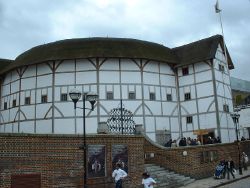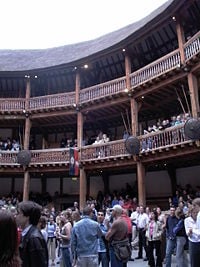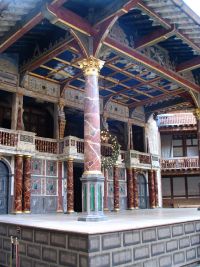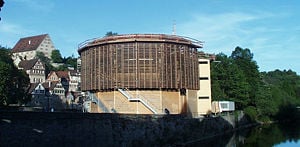Globe Theatre
| Globe Theatre | |
 | |
| Building | |
|---|---|
| Type | Theatre |
| Architectural Style | Replica Elizabethan |
| Structural System | Wood |
| Location | London, England |
| Construction | |
| Completed | 1997 |
| Main Contractor | McCurdy & Co. Ltd. |
| Design Team | |
| Architect | Pentagram |
| Structural engineer | Buro Happold |
| Services engineer | Buro Happold |
| Other designers | McCurdy & Co. Ltd. (timber consultant) |
| Quantity Surveyor | Boyden & Co |
The Globe Theatre normally refers to one of three theaters in London associated with William Shakespeare. These are:
- The original Globe Theatre, built in 1599 by the playing company to which Shakespeare belonged, and destroyed by fire on June 29, 1613.
- The Globe Theatre was rebuilt by June, 1614 and closed in 1642.
- A modern reconstruction of the original Globe, named "Shakespeare's Globe Theatre" or the "New Globe Theatre," opened in 1997.
Shakespeare's company erected the storied Globe Theatre, circa 1599, in London's Bankside district. It was one of four major theaters in the area, along with the Swan, the Rose, and the Hope. The open-air, octagonal amphitheater rose three stories high with a diameter of approximately 100 feet, holding a seating capacity of up to 3,000 spectators. The rectangular stage platform on which the plays were performed was nearly 43 feet wide and 27 feet deep. This staging area probably housed trap doors in its flooring and primitive rigging overhead for various stage effects.
In 1613, the original Globe Theatre burned to the ground when a cannon shot during a performance of Henry VIII ignited the thatched roof of the gallery. The company completed a new Globe on the foundations of its predecessor before Shakespeare's death. It continued operating until 1642, when the Puritans closed it down (and all the other theaters, as well as any place, for that matter, where people might be entertained). Puritans razed the building two years later in 1644 to build tenements upon the premises. The Globe would remain a ghost for the next 352 years.
The foundations of the Globe were rediscovered in 1989, rekindling interest in a fitful attempt to erect a modern version of the amphitheater. Led by the vision of the late Sam Wanamaker, workers began construction in 1993 on the new theater near the site of the original. The latest Globe Theatre was completed in 1996; Queen Elizabeth II officially opened the theater on June 12, 1997 with a production of Henry V. The Globe is as faithful a reproduction as possible to the Elizabethan model, seating 1,500 people between the galleries and the "groundlings," commoners who sat on the ground to see the plays. In its initial 1997 season, the theater attracted 210,000 patrons.
The original Globe
The original Globe was an Elizabethan theatre which opened in Autumn 1599 in Southwark, on the south bank of the Thames, in an area now known as Bankside. It was one of several major theaters that were located in the area, the others being the Swan, the Rose, and The Hope. The Globe was the principal playhouse of the Lord Chamberlain's Men (who would become the King's Men in 1603). Most of Shakespeare's post-1599 plays were staged at the Globe, including Julius Caesar, Macbeth, Othello, King Lear and Hamlet.

The Globe was owned by many actors, who (except for one) were also shareholders in the Lord Chamberlain's Men. Two of the six Globe shareholders, Richard Burbage and his brother Cuthbert Burbage, owned double shares of the whole, or 25 percent each; the other four men, Shakespeare, John Heminges, Augustine Phillips, and Thomas Pope, owned a single share, or 12.5 percent. (Originally William Kempe was intended to be the seventh partner, but he sold out his share to the four minority sharers, leaving them with more than the originally planned 10 percent). These initial proportions changed over time, as new sharers were added. Shakespeare's share diminished from 1/8 to 1/14, or roughly 7 percent, over the course of his career.
The Globe was built in 1599 using timber from an earlier theater, The Theatre, that had been built by Richard Burbage's father, James Burbage, in Shoreditch in 1576. The Burbages originally had a 20-year lease of the site on which The Theatre was built. When the lease ran out, they dismantled The Theatre beam by beam and transported it over the Thames to reconstruct it as The Globe.
On June 29, 1613, the Globe Theatre went up in flames during a performance of Henry the Eighth. A theatrical cannon, set off during the performance, misfired, igniting the wooden beams and thatching. According to one of the few surviving documents of the event, no one was hurt except a man who put out his burning breeches with a bottle of ale.[1]
Like all the other theaters in London, the Globe was closed down by the Puritans in 1642. It was destroyed in 1644 to make room for tenements. Its exact location remained unknown until remnants of its foundations were discovered in 1989 beneath Anchor Terrace on Park Street. There may be further remains beneath Anchor Terrace, but the eighteenth-century terrace is listed and may not be disturbed by archaeologists.[2]
Layout of the Globe
The Globe's shape and size have been pieced together by scholarly inquiry over the last two centuries. The evidence suggests that it was a three-story, 100-foot-wide, open-air amphitheater that could house around 3,000 spectators. The Globe is shown as a round building on a contemporary engraving of London. On this basis, some assume the building was circular, while others favor a polygonal shape. Archaeological evidence suggests the playhouse had twenty sides.[2]
At the base of the stage, there was an area called the pit, or yard, where, for a penny, people (the "groundlings") would stand to watch the performance. Groundlings would eat hazelnuts during performances — during the excavation of the Globe nutshells were found preserved in the dirt, or oranges.
Around the yard were three levels of seating, which were more expensive than standing. The first two were called the Twopenny Rooms. and the top level was called the Penny Gallery.
A rectangular stage platform, also known as an 'apron stage,' thrust out into the middle of the open-air yard. The stage measured about 43 feet in width, 27 feet in depth, and was raised about 5 feet off the ground. On this stage, there was a trap door for use by performers to enter from the "cellarage" area beneath the stage. There may have been as many as four smaller trap doors around the stage. Often the area beneath the stage is also called "hell," since supernatural beings (such as the ghost in Hamlet) enter and exit the stage from this area.
Large columns on either side of the stage supported a roof over the rear portion of the stage. This ceiling was called the "heavens," and was possibly painted with images of the sky. A trap door in the heavens enabled performers to "fly," or descend, using some form of rope and harness.
The back wall of the stage had three doors on the first floor and a balcony on the second. The doors entered into the "tiring house" (backstage area) where the actors dressed and awaited their entrances. The balcony housed the musicians and could also be used for scenes requiring an upper space, such as the balcony scene in Romeo and Juliet. In addition, it could be used as the "Lord's Room," where higher-paying audience members could be seated – more to be seen than to see the play, since they would have been behind the performers.
The dimensions of the original Globe:[3]
- Diameter: 100 ft. surface to surface / 99 ft. center to center
- Yard: 70 ft. between post centers / 69 ft. surface to surface
- Stage: 49 ft., 6 in. across, 27 ft. deep
- Stage height: 5 ft.
- Gallery Depth: 15 ft., 6 in. overall / 15 ft., 6 in. between post centers
- Overall height: 36 ft., 6 in.
- Overall heights from floor to floor: 15 ft., 6 in.; 11 ft., 3 in.; and 9 ft., 9 in. to the plates.
- Balcony floor: 18 ft., 6 in. above the yard; 13 ft., 6 in. above stage
- Front Scenae doors: 11 ft. tall
- Heavens ceiling height: 26 ft., 9 in. to the height of the upper gallery floor
The modern Globe
At the instigation of Sam Wanamaker, a new Globe theatre was built according to an Elizabethan plan. The design team comprised Theo Crosby of Pentagram as the architect, Buro Happold as structural and services engineers and Boyden & Co as quantity surveyors.[4] It opened in 1997[5] under the name "Shakespeare's Globe Theatre" and now stages plays every summer (May to October). Mark Rylance was appointed as the first artistic director of the modern Globe in 1995. In 2006, Dominic Dromgoole took over.[6]
The new theatre is 200 yards (183m) from the original site, and was the first thatched roof building permitted in London since the Great Fire of London in 1666.[citation needed]
As in the original Globe, the theatre is open to the sky and has a thrust stage that projects into a large circular yard surrounded by three tiers of steeply raked seating. 700 tickets to stand (and you must stand, no sitting allowed) in the yard are available for every performance at 5 pounds each. The only covered parts of the amphitheatre are the stage and the (more expensive) seated areas. Plays are put on during the summer, usually between May and the first week of October. In the winter the theatre is used for educational purposes. Tours are available all year round.
The reconstruction was carefully researched so that the new building would be as faithful a replica as possible. This was aided by the discovery as final plans were being made of the site of the original Globe itself. Modernisations include the addition of sprinklers on the roof to protect against fire, and the fact that the theatre is partly joined onto a modern lobby, visitors centre and additional backstage support areas. Due to modern Health and Safety regulations 1,300 people can be housed during a show,[citation needed] under half the estimated 3,000 of Shakespeare's time.[citation needed]
Replicas
A number of replicas of the Globe have been built around the world:
- U.S.A.
- OSF Elizabethan Theatre, Ashland, Oregon, built in 1935, rebuilt 1947 and 1959
- San Diego, Old Globe Theatre, built in 1935[7]
- Cedar City, Utah, Adams Shakespearean Theatre
- Chicago, Illinois, Chicago Shakespeare Theatre on Navy Pier, built 1999[8]
- Dallas, Texas, Old Globe Theatre, built 1936[9]
- Odessa, Texas, The Globe Theatre Of The Great Southwest
- Williamsburg, Virginia, Globe Theatre, built 1975 in the Banbury Cross section of Busch Gardens Europe [3]
- Germany
- Neuss am Rhein, Globe Neuss, built 1991
- Rust, Baden, Germany (in German), Europa-Park (in German), built 2000
- Italy
- Czech Republic
- Japan
- Tokyo, Isozakia Arata's Panasonic Globe Theatre in Tokyo, built 1988
Replica of similar Elizabethan theatre:
- Waseda University Tsubouchi Shoyo Memorial Library Theatre (a replica of The Fortune Theatre), built early 1900s
Notes
- ↑ Globe Theatre Fire.
- ↑ 2.0 2.1 Mulryne, J R and Shewring, Margaret (1997). Shakespeare’s Globe Rebuilt. Cambridge University Press. ISBN 0521599881.
- ↑ Orrell, John, The Quest for Shakespeare's Globe.
- ↑ [1].
- ↑ [2].
- ↑ Dominic Dromgoole appointed Artistic Director. The Shakespeare Globe Trust. Retrieved 2007-03-19.
- ↑ The Old Globe, San Diego.
- ↑ Chicago Shakespeare Theatre.
- ↑ Further Replicas (in German).
- ↑ Italy gets Globe Theatre replica.
- ↑ The Globe Theatre in Prague - More Information about the Disaster.
ReferencesISBN links support NWE through referral fees
- Nagler, A.M. Shakespeare's Stage, Yale University Press, 1958. ISBN 0300026897
- Schoenbaum, Samuel. Shakespeare's Lives, Clarendon Press, 1991. ISBN 0198186185
- Day, Barry. This Wooden 'O': Shakespeare's Globe Reborn, Oberon Books, 1997. ISBN 1-870259-99-8
- Rylance, Mark. Play: A Recollection in Pictures and Words of the First Five Years of Play at Shakespeares's Globe Theatre, Shakespeare's Globe Publications, 2003. ISBN 0-9536480-4-4
External links
- Globe Theatre Study Guide
- Shakespeare's Globe Theatre website
- Entertainment at Shakespeare's Globe Theatre
- 3D Model of Globe Theatre done by Wesleyan University's Learning Objects Studio
Credits
New World Encyclopedia writers and editors rewrote and completed the Wikipedia article in accordance with New World Encyclopedia standards. This article abides by terms of the Creative Commons CC-by-sa 3.0 License (CC-by-sa), which may be used and disseminated with proper attribution. Credit is due under the terms of this license that can reference both the New World Encyclopedia contributors and the selfless volunteer contributors of the Wikimedia Foundation. To cite this article click here for a list of acceptable citing formats.The history of earlier contributions by wikipedians is accessible to researchers here:
The history of this article since it was imported to New World Encyclopedia:
Note: Some restrictions may apply to use of individual images which are separately licensed.

